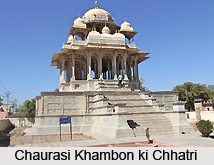 The places of interest in Bundi are well known for their architectural grandeur. These display the essential Rajasthani artwork and craftsmanship. Though the entire place has a desolate look yet this desolation is charming. People from across the world visit this quaint town to bask in its beauty. There are few but interesting places of interest in Bundi. The travelers can start with the Taragrh Fort that stands as a witness to the medieval and later history of Bundi.
The places of interest in Bundi are well known for their architectural grandeur. These display the essential Rajasthani artwork and craftsmanship. Though the entire place has a desolate look yet this desolation is charming. People from across the world visit this quaint town to bask in its beauty. There are few but interesting places of interest in Bundi. The travelers can start with the Taragrh Fort that stands as a witness to the medieval and later history of Bundi.
The Garh Palace: Climbing the steep cobbled ramp, the palace is reached through two massive gateways - Hazari Pol and Hathi Pol, where two enormous elephants with raised trunks painted in bright colours top the gateway. The Hathi Pol will lead the tourists to the inner courtyard. Within this inner courtyard lies the Diwan-i-Aam or the hall of public audience. The inner courtyard surrounded by arched arcades and stables has some outstanding murals and there is a white marble throne used for coronation ceremonies. There are several palaces within its premises. The most striking one amongst these is the Chattar Mahal. There is also the Chitra Mahal (Palace of Paintings). The architecture of this monument is truly impressive.
 The Deeg Palace: Below the Garh Palace lies the artificial 18th century lake, Nawal Sagar. Apart from its contribution to the pictorial beauty of the surrounding it also reflects the image of the palace and the entire town of Bundi. At its centre stands a temple dedicated to God of Water.
The Deeg Palace: Below the Garh Palace lies the artificial 18th century lake, Nawal Sagar. Apart from its contribution to the pictorial beauty of the surrounding it also reflects the image of the palace and the entire town of Bundi. At its centre stands a temple dedicated to God of Water.
Chaurasi Khambon ki Chhatri: To the south of the town is this magnificent unique double Chhatri built in the year 1683. This has been constructed on a high platform and at the center one will come across a Shiva linga. The walled enclosure has animal motifs and strikingly beautiful etchings adorn the columns. The themes of the paintings on the ceilings are varied including interesting fish symbols. Other subjects comprise of about 50 odd impressive baoris. The most famous and well maintained 46 m deep Rani ji-ki-Baori (Queen`s Stepwell). It was built in 1699 and has some superb carving on its pillars and a highly ornamented arched gate.
Jait Sagar: This lies to the northeast of the town. On its banks of the Sukh Mahal is located and it was built in 1773 A.D. to the north of Jait Sagar is the Shikar Burj, a small hunting lodge of Bundi`s Maharaos. As of now it has been converted into a famous picnic spot. The royal garden is also worth visiting. It houses monuments of the dead monarchs, queens and princes and is known as the Keshar Bagh. The chhatris here are built of pristine white marbles, carved elephants and topped with a Shiva linga.



















